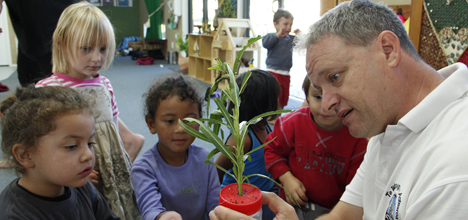Tauranga pre-schoolers are more empathetic and knowledgeable about monarch butterflies after a lesson on them from enthusiast Darren Gedye.
After reading an article in The Weekend Sun about Darren tagging monarch butterflies for research for the Monarch Butterfly NZ Trust, Maungaarangi Kindergarten asked Darren to come in and talk to the children.
Darren Gedye talks to children at Maungaarangi Kindergarten about caring for caterpillars and monarch butterflies. Photo by Tracy Hardy.
Kaiako Roxy Burt at the new kindergarten in Welcome Bay says the 30 children have been doing many projects and art work on butterflies.
Roxy says the story in The Weekend Sun has helped them to extend their children's knowledge about butterflies.
'We've been doing heaps of projects on life cycles, so Darren talked to the children about the life cycle of the butterflies and how we can look after them.
'It fits in well with part of our curriculum of looking after the environment.
'The kids really enjoyed it – they love butterflies. We sang the songs we've been learning about butterflies.”
The children all took turns to hold the caterpillars and Roxy says it was a good way of growing the children's empathy.
'Darren told us how to be careful and gentle with them.
'They all had to wait for their turn to hold the caterpillar.”
Roxy says it was great to get the outside input into the children's learning.
'Part of our policy is seeking knowledge from outside our doors – from our community. 'Darren is a rich source of knowledge. He is going to help us grow a butterfly garden.”
Darren, also an early childhood teacher, says tagging monarchs is a 'great hands-on science project for kids”.
He says he has never met a child who is not interested in butterflies.
'The monarch is the most recognised insect in the world – people just love them,” says Darren.
He is encouraging people to tag autumn butterflies so the Monarch Butterfly NZ Trust can learn more about where they go during the winter.
During winter months, monarchs typically form large clusters, sometimes containing hundreds or thousands of butterflies, on trees in well-sheltered areas. Clusters have been spotted wintering in trees around Tauranga and Omokoroa.
The trust is hoping volunteers will tag 20,000 monarchs this year.
Darren says the butterflies are actually quite tough and when tagging them, people need to pinch a finger on either side, but take care not to rub the wings when putting the tags on.
'The caterpillars only eat milk weeds which are poisonous, which is why birds don't eat them. That's why they are so colourful – they are advertising that they're poisonous – they fly slowly and gracefully, and they don't eat our cabbages. They're everybody's favourite butterfly.”
People can register for free tags at www.www.monarch.org.nz



2 comments
Posted on 04-04-2011 15:19 | By Darren
there are too many "www"s in that website address. It should be: http://www.monarch.org.nz/monarch/tagging-transects/
Posted on 04-04-2011 15:22 | By Darren
"milk weeds" should be milkweeds Milkweed or the Asclepiadoideae is a large family of plants with only a handful available in NZ. It is the host plant for the Monarch butterfly, which lays its eggs on the plant, and then the caterpillars begin to eat the leaves. It is named for its milky juice, which contains alkaloids, latex, and several other complex compounds including cardenolides. Some species are known to be toxic. However, do not get the plant family confused with plants such as dandelion, sow thistles, portulaca and Euphorbia species etc. - all of which also have a milky sap. Milkweed originates on two continents - the African and the American continents. The species that come from Africa were renamed ‘Gomphocarpus' by Kew Gardens botanists. The American species are known as ‘Asclepias', but all are members of the Asclepiadoideae family. from http://www.monarch.org.nz/monarch/monarchs/monarch-host-plants/milkweed/
Leave a Comment
You must be logged in to make a comment.